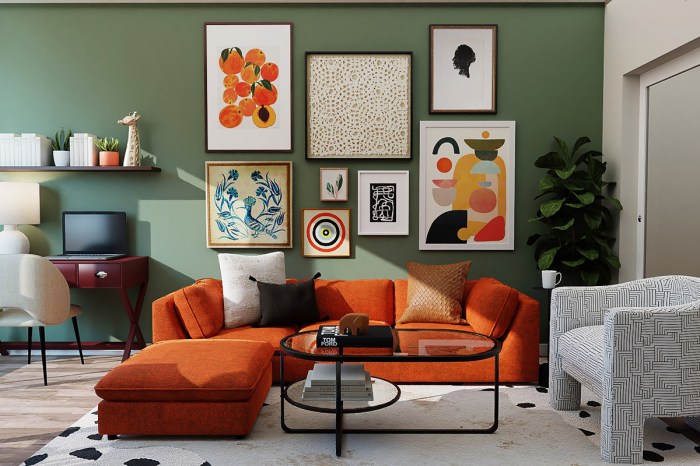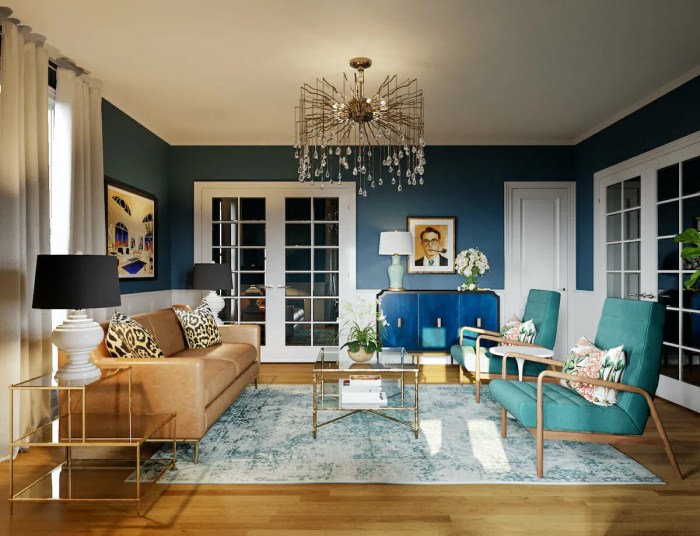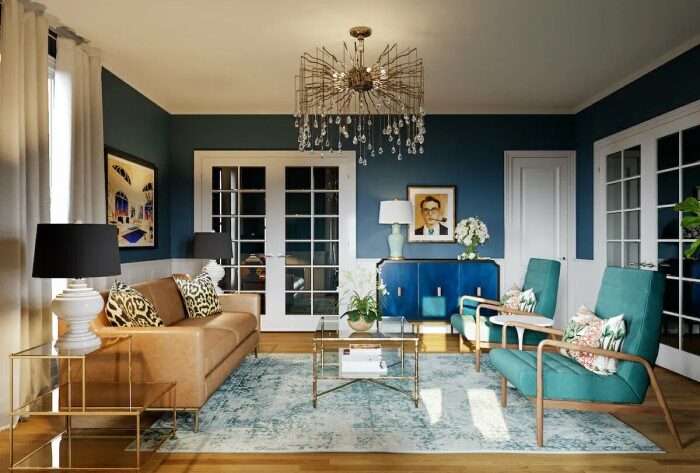Colorful house interior design is more than just adding splashes of color; it’s about crafting a space that reflects your personality and evokes desired emotions. From understanding the psychology of color to choosing the right palettes and incorporating furniture and decor, this guide will help you transform your home into a vibrant and inviting sanctuary.
Imagine walking into your living room, greeted by a warm and inviting atmosphere, a space that not only looks stunning but also makes you feel relaxed and happy. This is the power of color in interior design. By understanding the principles of color theory and its impact on mood, you can create spaces that are both visually appealing and emotionally resonant.
Introduction to Colorful House Interior Design

Color plays a significant role in interior design, shaping the mood, atmosphere, and overall feel of a space. Understanding the psychology of color and its impact on human emotions is crucial for creating a harmonious and inviting home.
The Psychology of Color
Color psychology explores the connection between colors and human emotions, perceptions, and behaviors. Each color evokes specific feelings and associations, influencing how we perceive a space.
While colorful house interior design can be bold and exciting, some prefer the timeless elegance of a classic house design interior. If you’re drawn to intricate moldings, rich fabrics, and a sense of history, you might want to explore the world of classic house design interior.
However, don’t discount the power of color to add personality and vibrancy even within a classic framework. A touch of color can breathe life into a traditional setting, creating a truly unique and inviting space.
- Warm Colors, such as red, orange, and yellow, are associated with energy, excitement, and warmth. These colors can stimulate appetite and create a sense of vibrancy.
- Cool Colors, including blue, green, and purple, are often linked to calmness, relaxation, and tranquility. They can create a soothing and serene atmosphere, ideal for bedrooms and bathrooms.
- Neutral Colors, such as white, black, gray, and beige, provide a sense of balance and sophistication. They serve as a blank canvas, allowing other colors to stand out and create visual interest.
Using Color to Create Different Feelings
Color can be strategically used to create distinct moods and atmospheres in different areas of the home.
- Living Room:A vibrant and inviting living room can be achieved by incorporating warm colors like orange or yellow. These colors can stimulate conversation and create a lively atmosphere.
- Bedroom:Cool colors such as blue or green are ideal for creating a calming and relaxing bedroom environment, promoting restful sleep.
- Kitchen:Warm colors like red or yellow can stimulate appetite and create a cheerful atmosphere in the kitchen.
- Bathroom:Cool colors like blue or green can create a spa-like ambiance in the bathroom, promoting relaxation and tranquility.
Considering Natural Light and Space Size
Natural light and the size of the space are important factors to consider when choosing colors.
- Natural Light:Darker colors can absorb light, making a space feel smaller and darker. Lighter colors reflect light, creating a sense of spaciousness and brightness.
- Space Size:In smaller spaces, lighter colors can make the space feel larger and more open. In larger spaces, darker colors can create a cozy and intimate atmosphere.
Color Schemes and Palettes: Colorful House Interior Design
A well-chosen color scheme can dramatically impact the overall feel and atmosphere of a house interior. There are various color schemes to explore, each offering unique possibilities for creating visually appealing and harmonious spaces. Understanding these color schemes is crucial for selecting the right colors for your home and achieving the desired aesthetic.
Popular Color Schemes
Color schemes are a fundamental aspect of interior design, offering a structured approach to combining colors harmoniously. They provide a framework for selecting colors that complement each other, creating a cohesive and visually pleasing aesthetic. Understanding popular color schemes can guide you in choosing colors for your home, ensuring a balanced and visually appealing outcome.
- Complementary Color Schemes: These schemes use colors that are opposite each other on the color wheel, such as red and green, blue and orange, or yellow and purple. Complementary colors create high contrast and visual excitement, making them ideal for creating focal points or adding a dramatic touch.
- Analogous Color Schemes: These schemes use colors that are adjacent to each other on the color wheel, such as blue, blue-green, and green. Analogous colors create a sense of harmony and tranquility, making them suitable for creating relaxing and cohesive spaces.
- Triadic Color Schemes: These schemes use three colors that are evenly spaced on the color wheel, such as red, yellow, and blue. Triadic colors offer a balanced and vibrant aesthetic, creating visually interesting and dynamic spaces.
Designing a Living Room Color Palette
Let’s illustrate how to apply a color scheme to design a living room color palette. Imagine we want to create a warm and inviting living room using an analogous color scheme. We can choose a base color of warm beige, which is a neutral and calming hue.
We can then select two adjacent colors from the color wheel, such as terracotta red and burnt orange. These colors will create a warm and inviting atmosphere, adding depth and visual interest to the space.
Adding pops of color to your house can instantly brighten up the mood and make your space feel more inviting. While a colorful palette can work wonders in any size home, it’s especially effective in smaller spaces. If you’re working with a 1000 square feet house, 1000 square feet house interior design ideas can help you maximize your space while incorporating your favorite colors.
You can use bright accents on furniture, artwork, or even just a single wall to create a vibrant and dynamic atmosphere.
- Base Color: Warm beige (for walls, furniture, and flooring)
- Accent Color 1: Terracotta red (for throw pillows, artwork, or a statement rug)
- Accent Color 2: Burnt orange (for curtains, lamps, or decorative accents)
Accent Colors
Accent colors play a crucial role in adding pops of vibrancy and personality to any space. They are typically used in smaller doses, such as through throw pillows, artwork, or decorative accents. Accent colors can be chosen to complement the main color scheme or introduce a contrasting element.
For example, in a living room with a neutral color scheme, a bold accent color like turquoise blue can add a touch of energy and sophistication. Accent colors can also be used to highlight specific features, such as a fireplace or a bookshelf.
By strategically placing accent colors, you can create visual interest and draw attention to key elements in the room.
Using Color in Different Rooms
Color plays a crucial role in interior design, influencing mood, functionality, and overall aesthetics. When choosing colors for different rooms, it’s important to consider the intended purpose of the space and how color can enhance its functionality.
Color Palettes for Different Rooms
Color palettes can significantly impact the feel of a room. Here’s a table outlining suggested color palettes for various rooms:
| Room | Color Palette |
|---|---|
| Kitchen | Warm neutrals (cream, beige, taupe), accented with vibrant colors (red, yellow, green) |
| Bedroom | Cool and calming colors (blue, green, lavender), or warm and inviting colors (yellow, orange, red) |
| Bathroom | Cool and refreshing colors (blue, green, gray), or warm and spa-like colors (cream, beige, brown) |
Color’s Impact on Functionality
Color can be used to enhance functionality in different rooms. For example, in a bedroom, cool colors like blue and green can create a calming atmosphere conducive to sleep, while warm colors like yellow and orange can promote energy and creativity in a home office.
Color Choices for Small and Large Spaces
Color can be used to visually manipulate space. Light colors like white, cream, and pale blue can make small spaces feel larger, while dark colors like navy, charcoal, and deep green can create a cozy and intimate atmosphere in large spaces.
For small spaces, using lighter colors on walls and ceilings can help reflect light, making the space feel more open and airy.
For large spaces, using darker colors on walls can create a sense of intimacy and coziness, making the space feel more inviting.
Injecting color into your home can be a fun and exciting way to express your personality. But if you’re aiming for a more mature and sophisticated aesthetic, consider incorporating elements of 20 30 house interior design to achieve a balanced look.
This style often utilizes a neutral color palette with pops of color in accessories and artwork, creating a sophisticated and welcoming space.
Color Trends and Inspiration

Color trends in house interior design are constantly evolving, reflecting changing tastes and societal influences. Understanding these trends can help homeowners create stylish and personalized spaces that resonate with current aesthetics.
Cultural Influences on Color Choices, Colorful house interior design
Different cultures around the world have unique color associations and traditions that impact interior design. For example, in many Asian cultures, the color red is associated with good luck and prosperity, often used in accents and decorations. In contrast, Western cultures may view red as a more vibrant and energetic color, used to create a bold statement.
- Scandinavian Design: This style emphasizes simplicity and functionality, often incorporating a neutral palette with pops of color in accents and furniture. The use of natural light and clean lines contributes to a calming and minimalist aesthetic.
- Mid-Century Modern: This design movement celebrates bold colors and geometric patterns. Popular colors include mustard yellow, teal blue, and burnt orange, often used in furniture and upholstery.
- Bohemian Style: This eclectic style incorporates a mix of textures and colors, drawing inspiration from global influences. Think vibrant rugs, patterned textiles, and rich jewel tones.
Examples of Colorful House Interiors
- Modern Farmhouse: This style combines the rustic charm of farmhouse design with modern elements. Popular color combinations include navy blue and white, with pops of yellow or green for a vibrant touch.
- Contemporary Living Room: A contemporary living room might feature a neutral backdrop with bold accents in vibrant hues. For example, a gray sofa could be paired with bright orange throw pillows and a geometric rug.
- Eclectic Kitchen: An eclectic kitchen can incorporate a mix of colors and patterns, creating a visually stimulating and unique space. For example, a colorful backsplash could be paired with bold cabinetry and patterned countertops.
Closure

As you embark on your colorful house interior design journey, remember that there’s no right or wrong way to approach it. Experiment, explore, and have fun with color! Embrace your personal style and create a home that truly reflects who you are.
With a little creativity and inspiration, you can transform your house into a vibrant and joyful haven.
FAQ Compilation
What are some popular color schemes for house interiors?
Some popular color schemes include complementary (opposite colors on the color wheel, like blue and orange), analogous (colors next to each other on the color wheel, like blue and green), and triadic (three colors equally spaced on the color wheel, like red, yellow, and blue).
How can I incorporate color into a small space without making it feel cramped?
Use lighter colors on walls and ceilings to create a sense of spaciousness. Introduce pops of color through furniture, artwork, and accessories.
What are some eco-friendly paint options?
Look for paints made with low-VOC (volatile organic compounds) formulas, natural pigments, and recycled materials. Some brands also offer plant-based paints.




